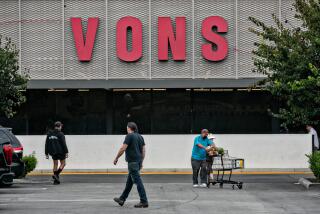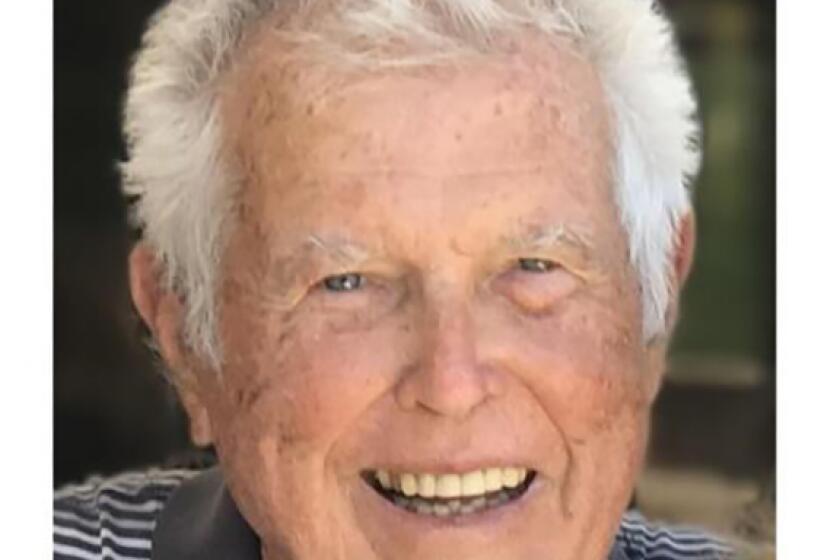Open Door for the Poor : Doctor, Staff Treat All Comers at Clinic Periled by County Budget Crisis
In the middle of another 13-hour day of coddling newborns, examining 50 older children and explaining heart defects, ear infections and other ailments both serious and minor to anxious parents, Dr. Ramasamy Mahadevan still manages a small smile.
For 16 years, he has worked at the county clinic at High Desert Hospital in Lancaster--the only pediatrician between Santa Clarita and Bakersfield who cares full time for indigent children. Their parents lack money or medical insurance, and often drive miles from remote outposts in the High Desert to seek help for their children.
“People come here,” said Thomas Bretz, a registered nurse at the clinic, “because it’s the last stop on the road.”
That is true literally and figuratively.
The modest clinic is a trailer parked in a section of town boxed in by correctional institutions--a state prison, the now-closed Mira Loma Jail and a juvenile probation center.
It is little more than a blip on the dry, stubborn flatness of the Antelope Valley. But for poor families in the region, there are few options. Mahadevan’s services do not go wanting in an area with an under-17 population of about 70,000 and a poverty rate of about 8.5%.
Each month, 900 to 1,000 people line up for services such as having prescriptions filled and getting checkups. About 400 of those seeking walk-in exams have to be rescheduled but are eventually seen, in keeping with Mahadevan’s ideal: “If you need help, we don’t turn you away.”
*
The clinic’s days, however, could be numbered. Los Angeles County’s public health care system--the nation’s second largest with 1,342 clinics, 39 health centers and nearly 29,000 employees--is in line for substantial restructuring and widespread layoffs in the next several months.
As the nation’s health care is increasingly dominated by for-profit hospitals and health maintenance organizations and there is a shortage of pediatricians willing to work in public facilities, Mahadevan is something of an oddity: a doctor who treats every patient who walks through the clinic’s squeaky door.
On a sunny day this month, 51 children were penciled in for appointments, and 20 or so other kids were in the waiting room. Of those without appointments, the doctor was able to see only six or seven of the sickest children. The rest were asked to return over the following three weeks.
A typical day, says the 53-year-old Mahadevan.
Few can pay for his inoculations, checkups and no-nonsense advice. Many, he believes--but never asks--are illegal immigrants who do not qualify for care under Medi-Cal, the state’s medical insurance for the poor. Others are children who are part of Head Start programs or the county’s foster care system. None fit easy stereotypes. All lack access to private health care.
“A lot of people lost aerospace jobs,” Mahadevan said. “But they have a home or a car . . . too many assets to qualify for Medi-Cal. So they end up with me.”
How long the clinic can continue taking all comers is unclear because of the passage of Proposition 187, which would bar illegal immigrants from receiving most medical care, among other public services. So far, implementation of the proposition has been blocked in court, but Mahadevan believes that turning people away from clinics like his would only increase demand for more expensive emergency room services, which Proposition 187 would still allow.
“We would rather take care of them on a routine basis than treat them on a catastrophic one,” he said. “We haven’t gotten to the point where we say, ‘Bad luck, you die.’ ”
Still, there is plenty of reason for gloom at the clinic.
The county Department of Health Services is $96 million in the hole this fiscal year, with projections rising higher: $606 million in 1995-96 and $628 million in 1996-97. Overall, the county deficit has been projected to be as high as $1.2 billion.
Rumors about the impending closure of one of six county-run hospitals as well as clinics and health centers have been circulating for weeks in the Hall of Administration, and the health department has devised a plan based on its projected deficit.
“Once we start talking about a deficit of $200 (million) to $300 million, we have to look at closing one of the mid-size hospitals,” said Walter Gray, assistant health director. “Our priorities are to try to preserve the trauma centers and emergency services. . . . But we really don’t know what the numbers are at this point.”
*
In a report presented to a state Senate committee this month, county Health Services Director Robert Gates wrote that to save $606 million in costs, the department might have to lay off more than 10,000 employees.
Commenting on the Republicans’ welfare reform bill in Congress, which would bar non-citizens, including legal immigrants, from receiving public health care, Gates warned that the plan could “aggravate the already tenuous health status of low-income families . . . and reduce medical benefits to legal residents, who represent 35% of the department’s patients.”
Last fiscal year, the county’s health care system handled 5.1 million outpatient visits and the six hospitals admitted 152,000 patients.
One solution being discussed is to send Medi-Cal patients in the county to private hospitals--and to the about 1,200 to 1,500 beds that remain empty daily. But some county health officials contend that private hospitals already accepting Medi-Cal patients are robbing the county of revenue for its health care system.
Health officials say that even if the county is able to avoid shutting down clinics or a hospital, the waits will be longer because of cutbacks in staffing. That makes Mahadevan’s clinic--with its annual operating budget of about $1.8 million--all the more valuable to his patients, who are well aware that their current level of care may not last.
The county has been trying to hire a second pediatrician at the clinic for three years, but there have been no takers.
“I don’t know what I’d do if this clinic wasn’t here,” said Patricia Anaya, 25, who just moved to Lancaster. “My kid would be sick and I couldn’t stand that. I don’t have anywhere else to go.”
Built in 1961 so Los Angeles County Jail inmates with tuberculosis could benefit from the desert air, High Desert Hospital has steadily outgrown its original facility. Most of its departments, including pediatrics, now operate inside trailers.
Later this year, construction is scheduled to begin on a new hospital--but even that will not have an emergency room or an obstetrics department, in part because of complaints from Antelope Valley Hospital, which is about seven miles away.
Mahadevan came to the Antelope Valley in 1979--specifically to run the pediatric clinic--after a residency in New York. It is a long way from his native Sri Lanka, but he has grown accustomed to the desert with its searing heat and isolation.
He has even gotten used to the relatively low pay: while county physicians of his experience make about $103,000 a year, the average private practice pediatrician starts out at $80,000 and can eventually earn more than $225,000 annually.
In the beginning, Mahadevan recalled, there were just three pediatricians in the entire Antelope Valley. Although there are about two dozen now, only a few are willing to see Medi-Cal patients, and he is the only one who treats those without any ability to pay.
The problem is one of statewide proportions, as Mahadevan sees it. Although Medi-Cal reimburses hospitals a reasonable amount for obstetrics, its repayment for pediatric services tends to be relatively low, making it not profitable enough for physicians and hospitals in the private sector to treat children from poor families.
*
The clinic fills up early. By the time Mahadevan gets there about 9 a.m., its staff of nine is hard at work, and the small waiting room is already filled with the cries of a dozen children with colds, infections and painful, mysterious rashes.
There are so many people, in fact, that one of the nurses spends a good part of the morning screening patients to make sure they need the doctor.
During the early morning this day, Mahadevan sees children with asthma, ear infections, epilepsy, common colds and mental and physical retardation.
In the clinic hallway, controlled chaos reigns. Still more children crowd around, waiting to take an eye test. Twins laugh and play--until they are told that they will have to get vaccinations, at which point they begin to cry. Other children hear the crying, and promptly join in.
Despite all the activity, the clinic manages to serve all its clients. Patients with appointments are seen on time. The clinic’s three nurses, two attendants and three clerks keep everyone moving. A nurse practitioner splits the patient load with the doctor.
A little before 1 p.m., Mahadevan rushes to his nearby home for a 45-minute lunch with his wife, a retired pharmacist. He rushes back, not missing a beat. Awaiting him is more of the same: children in the throes of coughing, sneezing, crying.
The afternoon also brings Elbia Benitez, 21, of Palmdale. She sits in the waiting room, nursing her 11-month-old son, who has a hole in his heart--in medical terms a ventricle septile defect.
Later, the doctor is interrupted by a phone call. A private physician wants to know if Mahadevan will see a patient with crossed eyes. The child’s family has no medical insurance. “Of course,” Mahadevan says once he is off the phone, “we don’t turn anyone away.”
Pausing, he smiles again: “We see everything. We don’t choose.”
More to Read
More to Read
More to Read
Start your day right
Sign up for Essential California for news, features and recommendations from the L.A. Times and beyond in your inbox six days a week.
You may occasionally receive promotional content from the Los Angeles Times.






